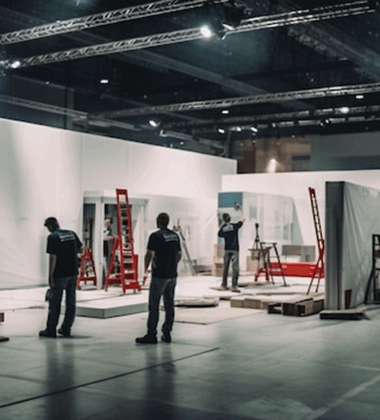Imagine stepping into a trade show where the boundaries between physical and digital blur, where attendees from across the globe can explore immersive exhibits, network seamlessly, and access real-time insights—all from the palm of their hand. This is the future of global trade shows, and it’s closer than you think.
The Global Products Expo, set to take place from June 26–28, 2025, at the New Jersey Expo Center, is already paving the way for this transformation. With industries like smoke, vape, CBD, cannabis, food, and beverages taking center stage, the expo is embracing cutting-edge trends that are reshaping the trade show landscape.
In this guide, we’ll explore the key trends shaping the future of global trade shows and what they mean for industry professionals.
1. Hybrid Events: The Best of Both Worlds
The pandemic accelerated the adoption of hybrid events, and they’re here to stay. Hybrid trade shows combine the best of in-person and virtual experiences, offering flexibility and accessibility to a global audience.
Key Features of Hybrid Events:
- Virtual Booths: Exhibitors can showcase their products in 3D virtual environments, allowing remote attendees to explore and interact as if they were there in person.
- Live Streaming: Keynotes, panels, and product demos are streamed live, enabling real-time participation from anywhere in the world.
- Networking Platforms: AI-powered matchmaking tools connect attendees with exhibitors and peers based on shared interests and goals.
Pro Tip: Invest in a robust hybrid event platform that integrates seamlessly with your in-person experience to maximize engagement and ROI.
2. AI and Data-Driven Insights
Artificial Intelligence is revolutionizing how trade shows are planned, executed, and measured:
Personalized Experiences
AI analyzes attendee data to provide personalized recommendations for sessions, exhibitors, and networking opportunities. This ensures that every participant gets the most out of the event.
Real-Time Analytics
AI-powered platforms track attendee behavior, booth traffic, and engagement levels in real time, enabling exhibitors to make on-the-spot adjustments to their strategies.
Predictive Event Management
AI systems can forecast attendee satisfaction, potential bottlenecks, and even weather disruptions, allowing organizers to proactively address issues before they arise.
3. Immersive Technologies: VR and AR
Virtual Reality (VR) and Augmented Reality (AR) are transforming how exhibitors showcase their products and how attendees experience trade shows:
Virtual Product Demos
Exhibitors can create immersive 3D demos that allow attendees to interact with products in a virtual environment. This is particularly valuable for industries like cannabis and food, where sensory experiences matter.
Augmented Reality Booths
AR overlays digital elements onto the physical world, enabling attendees to explore products in new ways. For example, a vape company could use AR to show how their products work without the need for physical samples.
Global Accessibility
VR eliminates geographical barriers, allowing attendees from around the world to participate in trade shows without the need for travel.
4. Sustainability and Eco-Friendly Practices
As environmental concerns grow, trade shows are adopting sustainable practices to reduce their carbon footprint:
Green Booths
Exhibitors are using eco-friendly materials, modular designs, and reusable components to create sustainable booths.
Digital Swag
Instead of physical giveaways, exhibitors are offering digital swag like e-books, discount codes, and virtual gift cards.
Carbon Offsetting
Event organizers are partnering with carbon offset programs to neutralize the environmental impact of travel and energy use.
5. Enhanced Networking and Matchmaking
Networking is the heart of any trade show, and technology is making it easier and more effective than ever:
AI-Powered Matchmaking
AI algorithms analyze attendee profiles to suggest relevant connections, ensuring that every interaction is meaningful.
Virtual Networking Lounges
Hybrid events feature virtual lounges where attendees can chat, exchange contact information, and schedule meetings.
Gamification
Gamified networking activities, like scavenger hunts or trivia contests, encourage engagement and make networking fun.
6. The Rise of Niche and Micro-Events
While large-scale trade shows remain popular, niche and micro-events are gaining traction:
Focused Audiences
Smaller events cater to specific industries or interests, allowing for deeper connections and more targeted marketing.
Localized Experiences
Micro-events held in regional hubs make it easier for local businesses and attendees to participate without the need for extensive travel.
Hybrid Integration
Even niche events are embracing hybrid models to extend their reach and accessibility.
7. The Role of Data Privacy and Security
As trade shows become more data-driven, protecting attendee information is paramount:
Secure Platforms
Event organizers are investing in secure platforms that comply with data privacy regulations like GDPR and CCPA.
Transparent Data Practices
Clear communication about how attendee data is collected, used, and protected builds trust and encourages participation.
8. The Future is Here
The future of global trade shows is no longer a distant dream—it’s happening now. By embracing hybrid models, AI, immersive technologies, and sustainable practices, trade shows are becoming more accessible, engaging, and impactful than ever before.
Ready to experience the future of trade shows? Register now for the Global Products Expo and be part of the revolution. Don’t miss out on this incredible opportunity to connect, engage, and grow in a whole new way.
By staying ahead of these trends, you’ll ensure your trade show presence stands out in the evolving landscape. See you at the New Jersey Expo Center, where the future of trade shows comes to life!





